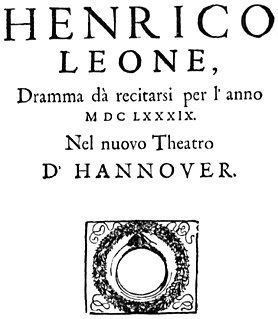
Servio Tullio is an opera composed by Agostino Steffani to a libretto by Ventura Terzago based on events in the life of the Roman king Servius Tullius. It was first performed in 1685. [2] [3] [4]

Servio Tullio is an opera composed by Agostino Steffani to a libretto by Ventura Terzago based on events in the life of the Roman king Servius Tullius. It was first performed in 1685. [2] [3] [4]

Cannoli are Italian pastries consisting of tube-shaped shells of fried pastry dough, filled with a sweet, creamy filling usually containing ricotta—a staple of Sicilian cuisine. They range in size from 9 to 20 centimetres. In mainland Italy, they are commonly known as cannoli siciliani.
Kapellmeister from German Kapelle (chapel) and Meister (master), literally "master of the chapel choir" designates the leader of an ensemble of musicians. Originally used to refer to somebody in charge of music in a chapel, the term has evolved considerably in its meaning and is today used for denoting the leader of a musical ensemble, often smaller ones used for TV, radio, and theatres.
Opera buffa is a genre of opera. It was first used as an informal description of Italian comic operas variously classified by their authors as commedia in musica, commedia per musica, dramma bernesco, dramma comico, divertimento giocoso.

Agostino Steffani was an Italian ecclesiastic, diplomat and composer.

Giovanni Legrenzi was an Italian composer of opera, vocal and instrumental music, and organist, of the Baroque era. He was one of the most prominent composers in Venice in the late 17th century, and extremely influential in the development of late Baroque idioms across northern Italy.

Lorenzo Ferrero is an Italian composer, librettist, author, and book editor. He started composing at an early age and has written over a hundred compositions thus far, including twelve operas, three ballets, and numerous orchestral, chamber music, solo instrumental, and vocal works. His musical idiom is characterized by eclecticism, stylistic versatility, and a neo-tonal language.

Cataldo Vito Amodei was an Italian composer of the mid-Baroque period who spent his career in Naples. His cantatas were important predecessors to the active cantata production of 18th-century Naples, and he stands with the elder Francesco Provenzale and younger Alessandro Scarlatti as among the principal cantata composers. Other surviving works include a book of motets dedicated to Leopold I, Holy Roman Emperor; a serenata; two pastorales; two psalms; and four oratorios, which were important contributions to their genre.

Princess Polyxena of Hesse-Rheinfels-Rotenburg was the second wife of Charles Emmanuel, Prince of Piedmont whom she married in 1724. The mother of the future Victor Amadeus III, she was Queen of Sardinia from 1730 until her death in 1735.

Maria Caniglia was one of the leading Italian spinto sopranos of the 1930s and 1940s.
Elisabetta Pilotti-Schiavonetti was an Italian operatic soprano who was associated with the House of Hanover. She was one of the leading prima donnas at the Queen's Theatre in the Haymarket from 1710 to 1717. She is best remembered today for creating roles in at least four operas by George Frideric Handel, possibly five. Three of the roles that Handel wrote specifically for her were sorceresses, and the demands of those roles indicate that she possessed an exceptional voice capable of both dramatic power and technical agility. She is said to have had a bitter rivalry with the Queen's other leading soprano, Isabella Girardeau.
Johann Hugo von Wilderer was a German Baroque composer. He was born in Bavaria and died in Mannheim, where in his later years he served as the Kapellmeister of the court orchestra. His compositions include eleven operas, two oratorios, cantatas, and sacred works.

Henrico Leone is an opera in three acts composed by Agostino Steffani to an Italian libretto by Ortensio Mauro. Based on the life of the powerful German prince Henry the Lion, the opera was first performed on 30 January 1689 in Hannover to inaugurate the new royal theatre in the Leineschloss.

(Bartolomeo) Ortensio Mauro was an Italian writer and librettist.
Francesco Palmieri was an Italian poet and musician.
Maria Landini was an Italian soprano who began her career as a singer at the court of Queen Christina in Rome but was primarily active at the imperial court in Vienna from 1711 until her death. She created numerous soprano roles in operas and oratorios by Fux, Caldara, and her second husband, Francesco Bartolomeo Conti and was reputedly the highest paid musician in Vienna at the time.
Orlando generoso is an opera of Agostino Steffani composed to a libretto by Ortensio Mauro after Ariosto's Orlando furioso. The opera was written in 1691, Steffani's fourth for the Duchy of Hanover. The opera was presented again in Hanover in 1692, and in 1695 it was performed at the Oper am Gänsemarkt in Hamburg.
Colin Ronald Timms is a musicologist and retired academic. He was Peyton and Barber Professor of Music at the University of Birmingham from 1992 until 2012, when he retired. After graduating from the University of Cambridge with a Bachelor of Arts degree, he completed Master of Music and Doctor of Philosophy degrees at King's College London, the latter in 1977 for his thesis on the chamber duets of Agostino Steffani. He was a lecturer at Queen's University Belfast from 1970 to 1972, and the University of Birmingham from 1973. In 2004, the British Academy awarded him the Derek Allen Prize for Musicology.
Gerhard Croll was a German-Austrian musicologist.
| Wikimedia Commons has media related to Servio Tullio (Steffani) . |